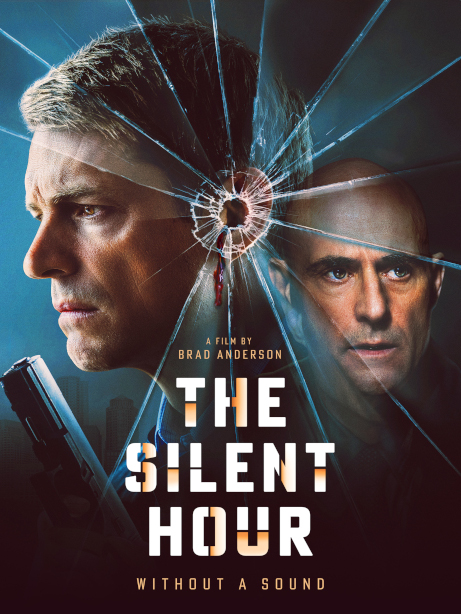Eye For Film >> Movies >> Silent Hour (2024) Film Review
Silent Hour
Reviewed by: Jane Fae

A little bit formulaic. Also, ever so slightly clunky in places. However, The Silent Hour more than delivers on its basic premise. It’s a competent cop action cliffhanger, with the requisite amount of suspense and character, and done well enough to hold the attention of this slightly jaded reviewer throughout.
Added bonus: sat alongside the usual bang-bang cops-n-villains antics, it also succeeded in providing a thoughtful and sympathetic exploration of a deeper issue. To wit, disability; here, deafness.

Basic premise. Frank Shaw is a Boston homicide detective. All you might expect from such a character, including firm set jawline, and a tendency to push the boundaries in pursuit of Justice with a capital J. The film opens with a raid gone wrong. Frank suffers an injury and… cut to 11 months later. How are the mighty fallen. Frank is now mostly recovered. Apart from the serious issue of his hearing, which is progressively deteriorating.
He is unhappy and contemplates turning in his badge. At which point, a call from former sidekick Doug Slater (Mark Strong) is catalyst to change. Because Doug needs an interpreter to interview Ava (Sandra Mae Frank) a deaf witness to a drugs homicide and hey! What better way to cheer Frank up?
The interview – in a near empty apartment block - does not go entirely well. End of story. Except, that is not the end, as corrupt cops are alerted to the existence of Ava. After Frank departs, they turn up to rid themselves of this inconvenient bystander, and are just about to do so, when…
Well, of course, Frank forgot his phone. Turns up in the nick of time, rescues Ava. All of which takes not much more than 15-20 minutes. Much of the rest of the film is taken up with good guy and gal playing hide and seek with the bad guys, who just happen to outnumber them, have more fire power, and control the dispatch desk at the local PD. So, help is not coming any time soon.
It’s a decent enough set-up. The hunter/hunted dynamic is realistic, low key. At the same time, this throwing together of Ava, Deaf from birth, and Frank, recently deafened, allows for exploration both of the world of deafness and of live issues within.
A significant part of the film is shot from their perspective. So, much of the dialogue is muffled. Blurred out with on-screen captions standing in for lip reading and signing. The viewer is very deliberately drawn into their world.
At the same time, several issues that, I suspect, are better understood within the Deaf community than in the wider (non-deaf) world are given prominence. Frank starts the action relying on technology – his hearing aids. It soon is clear, however, that these are as much hindrance as help. So, they are abandoned.
In the pause between fleeing and fighting back, there is room for the two lead characters to share. Ava understands Frank’s bitterness. His loss. At the same time, without sugar-coating the reality or diving into platitude, she helps show him that this is not the end, but a new beginning.
The film soundtrack contributes neatly to the sense of alienation; of setting apart from the hearing world, with background track alternating conventional melody with something far more ominous. A sort of rumble and rumination.
Also, as the action plays out, here and there nuggets, almost Easter Eggs, peppering the screen, reminding you that sound and hearing are central to this narrative. Residents of the apartment block are piping very loud music onto the street in protest at being evicted. Arriving on site, Doug comments, of Ava: “Lucky she’s deaf…she doesn’t have to listen to that all day long.”
Elsewhere, one of the villains observes, somewhat unnecessarily: “Don’t let them hear you coming.” The walls are peppered with graffiti extolling the value of…silence! Residents are exhorted to "make a noise" in protest. At every turn, reminders of the value mainstream culture attributes to hearing.
On the acting front, Mark Strong felt somewhat under-used. Perhaps, though, inevitable given the plot structure. There was a creditable performance, too, from chief villain Lynch (Mekhi Phifer). Last but by no means least, the presence of Sandra Mae Frank in this mainstream production is important recognition of the role of Deaf actors in telling their own stories.
Sandra Mae is Deaf, and has spent much of her life advocating for Deaf actors to be cast on the same level as hearing actors. More, she is a fierce critic of hearing actors being hired for Deaf roles. If, therefore, you suspect a certain woke sub-text in play here, you’d not be wrong.
Last up, all creds to director Brad Anderson for having the courage to bring this topic to the screen; and to writer Dan Hall, for whom this film appears to be a first outing on a major commercial script.
Formula and clunkiness, eh? Bring ‘em on!
Reviewed on: 27 Nov 2024
















